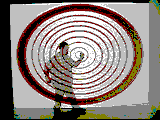View current page
...more recent posts
"Each pattern has the maximum complexity and 'resonance' for the minimum number of frames."
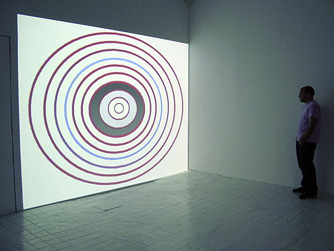 Paddy Johnson is interviewing me and Michael Bell-Smith this week about our shows; I hope you'll check it out.
Paddy Johnson is interviewing me and Michael Bell-Smith this week about our shows; I hope you'll check it out. "Geeks in the Gallery" is a three part discussion with artists Michael Bell-Smith and Tom Moody, which will run on Art Fag City from Monday June 12 – Wednesday, June 14, 2006. A recurring theme of the talk is how technology informs artistic production, as both artists have individually exhibited work usually described as New Media, yet also seem somewhat skeptical of "tech art." Moody’s "Room Sized Animated GIFs" at artMovingProjects in Brooklyn is comprised of animated GIFs projected or displayed on variable sized CRT monitors/tube televisions, plus a looping movie of the artist performing a computer-fabricated (but realistic-sounding) "guitar solo." The show dates are May 5th – June 25, 2006; it can also be viewed online on the artist's site. Bell-Smith's exhibit "Focused, Forward" closed last week at Foxy Production Gallery and included digital animations steeped in the aesthetics of '80s and '90s video games, a print depicting collaged patterns that create a virtual Tower of Babel, and a game table-like video sculpture with a simulated radar graph of birds circling over the White House. Show dates were April 27 – June 3, 2006; it can be viewed online at foxyproduction.com. [...]Some thoughful comments were made in response to my "preview remarks" about the interview and the general topic of "showing new media art in the gallery." I've replied to a couple of those, in the comment(s) to this post--anyone is welcome to chime in about that ongoing thread or the interview.
L.N.R., reBlogging at Eyebeam, makes the observation about the preview remarks: "Self indulgent, but interesting questions."
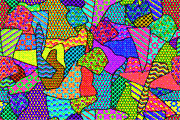


Curbed keeps us abreast of all the horrible "luxury condos" going up in the New York metropolitan area, has interesting views of things happening on the street (like the eviscerated rabbit in a block of ice found in Union Square), and great photo captions. "Jeremy's" are frequently on the money. This one reads "My architect assured me the changes had been made."
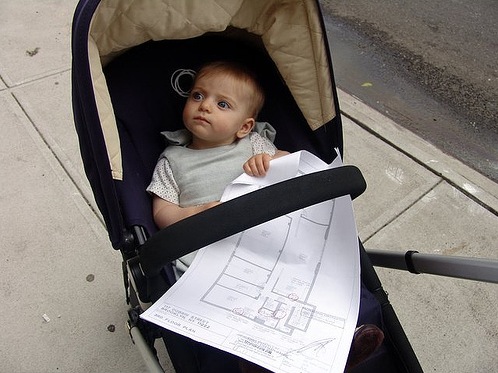
"Showing new media work in the gallery": what's at stake.
I have been working on a marathon interview that will be posted on the interviewer's site soon. The subject, more or less, is "showing new media work in the gallery," centering on my and another artist's current shows, and the interview has become like this insane Fluxus event where new information keeps surfacing and the dialogue goes on and on. I think it will be enjoyable to read, for all that.
I was talking to the interviewer yesterday and we uncovered more broad swaths of things that could have been said. Here's a summary of some of those items, before I forget, plus some stuff I just thought of.
1. The "tech discussion" is boring but there are some fundamental things that need to be covered. Specifically, what similarities exist between art and design in the web/computer environment and aesthetic principles of the art world. In the interview we talked some about the differences between the remixology/upload/download culture of the internet and the art world's need for defined, specific objects that can be shown in real space. My comments below are mostly about the similarities in the form of "minimalist" sensibilities common to the art and geek worlds.
2. Design consultant/philosopher/guru Edward Tufte talks about the need to reduce elements (in charts, etc) for maximum clarity and information flow. The minimalist sensibility in the art world talks about unnecessary gestures and ornamentation and "truth to materials" used to make art.
3. Software (e.g. Windows, Adobe) that is cluttered with unnecessary bells and whistles and extraneous lines of code is not beautiful or good. The "hacker aesthetic" seeks to remove this clutter (in Linux, Firefox, etc) so that users have more control over their lives.
4. Conceptualism in art also seeks to peel back the control mechanisms, to dismantle or parse the aura of the white cube and the mercantile systems underlying art (and therefore information) exchange.
5. In my case, my art is made in the simplest paint and GIF programs so I can eliminate some of the superfluous or overly controlling features of more "state of the art" software. Cory Arcangel and others have hacked even deeper--trusting only the numbers themselves under the graphic interfaces.
6. By putting the GIFs in the gallery (as videos), I'm making an immaterial art that is highly context dependent--depending on the shape of the room, lightness or darkness of walls and floor, and acoustics (for pieces with sound). I want the viewer to recognize the almost joke-like simplicity of the imagery (but not "overly simple," that's where the interviewer and I initially disagreed) and reflect on the mechanisms of the GIFs as well as the mechanisms of the white cube.
7. The other artist in the interview had similar goals but a very different approach, in that his presentation is more high tech and memory-intensive (even though his imagery is videogame-clunky), and the work is more absorbable into the gallery-collector-museum commodity stream by virtue of consisting of easily dispersable, physically portable pieces, with current hard drives, nice flat screen monitors etc..These "video-objects" will look pretty consistent everywhere they're shown, whereas mine change with the vagaries of available equipment and will be reconfigured on the fly for every space and hardware configuration. (Even though the underlying DVDs are offered for sale.) We never had a chance to really debate our different approaches, and I'm not sure we wanted to. Suffice it to say he has a better shot at posterity by meeting the commodity system halfway (as opposed to my quarter-way).
8. To sum up, the common (mostly unspoken) points of inquiry in the interview were: (i) what is the hacker aesthetic? (ii) what is the "gallery aesthetic"? (iii) how can these aesthetics be commingled? and most importantly, (iv) how can the viewer be made to understand these ideas just from viewing the work itself, without a podcast to explain it?
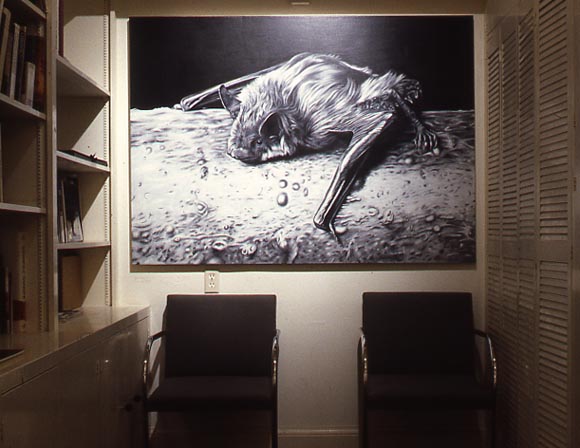
Large Bat, 1990, oil on canvas. The person who owned the gallery where I showed this was grossed out by it, but the gallery director liked it, so we hung it in her office during my show. I used to do a lot of photoreal-style paintings, many based on a book of copyright-free images called North American Mammals. (photo by Harrison Evans)
Cory Arcangel has created a web page with Kurt Cobain's suicide note that, when refreshed, pulls up different sets of Google Ads based on "keywords" in the letter. Pretty droll, and about says it all about our ad-annotated culture. I should say, so-called suicide note because, this being the first time I've read it, it sure didn't sound like he was planning to kill himself. More like, explaining why he was going to stop touring. As Paul notes, there is a conspiracy theory about the "suicide" that this note certain lends credence to.
"Piano Three Hands" [mp3 removed]. This will most likely be the first part of a longer work, posted in installments as I did with the string quartet piece a while back. The intro repeats at the end now, but I will probably take that out and add new material.
Update: Added an 18-second "middle section."

Bill Schwarz's 99 Bottles of Beer on the Wall begat Cady Noland, and Cady Noland begat...
Brooklyn-based artist Roy Stanfield, who has the most persuasive website of almost any artist whose work I've never seen, and whose drawings based on random Google image searches I posted about here. He's having a show at And/Or Gallery in Dallas, with Wendy Red Star.
Some photos of the show are here; the statement at the bottom of the page is very helpful.
The gallery's page documenting the show is here.
I'm being a bit cheeky about the website and all, but seriously, that is an inspiring series of photos documenting the artist's work. Almost no text is needed--with such a range of amusing, perplexing, and drop dead pretty installation shots (see the photos of skateboard ramps/swimming pools) the viewer supplies the back story and imagines radical exhibition scenarios that may or may not have happened. With its seamless mix of "exhibition space" and "environment" it is a thesis for an excellent career. Maybe I'll get to see the work in a New York gallery eventually.
